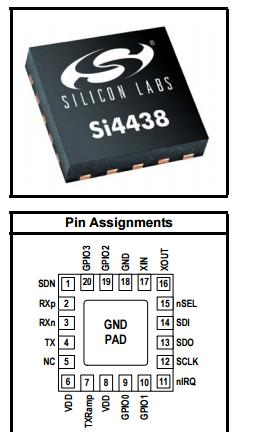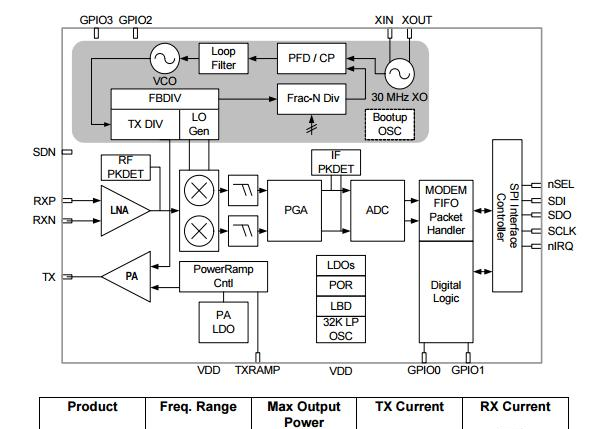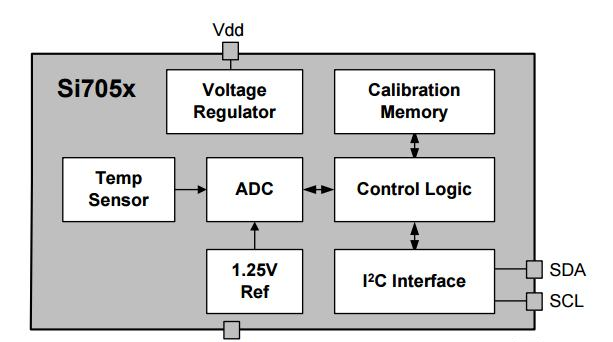基于EFM32HG210F32-QFN32/Si4438/Si7053主控器件的供暖数据采集器解决方案
 258
258
 拍明
拍明
概述
北方每年供暖季都出现供暖冷热不均的问题,一方面造成资源的浪费,一方面又因供暖温度不达标遭到用户的不断投诉。供暖数据采集器安放在每个入户单元的供热管道内,采集入水管道和出水管道内的水压和温度,然后通过无线把每个采集点的数据传输到汇集节点,汇集节点通过3G传输给后台进行监控。方案采用大容量3200mAH电池供电,由低功耗MCU、无线芯片,温度采集芯片和压力模块构成。产品要求电池要保证整个供暖季正常工作,此方案如两分钟采集一次能保证电池使用六个月,完全能满足产品的需求。

优势
· 低功耗32位MCU (EFM32HG210F32-QFN32)有8通道12位ADC采集,可在EM1睡眠模式下完成水压采集,温度采集和无线发送数据的功能,功耗仅45uA/MHz;此芯片具有32K FLASH,4K RAM,21个GPIO,满足此方案的需求而且留有余量以备后续升级。
【EFM32HG210F32-QFN32】
具有 EFM32HG210F32-QFN32 ARM Cortex-M0+ USB 的 32 位微控制器
EFM32HG210F32-QFN32 是具有 USB 的基于 ARM Cortex-M0+ 的微控制器 (MCU),速度可达 25 MHz,是 Happy Gecko 节能设备系列的一部分。建立在低能耗平台之上,该低能耗平台包括创新型低能耗技术、快速唤醒时间和最适合能源敏感应用的节能模式 EFM32HG210F32-QFN32。另外,本设备包括 32 kB 闪存、4 B RAM、24 数字 I/O 引脚、3 x 16 位定时器和多种通信接口。
规格摘要
MCU 内核:ARM Cortex-M0+ MHz:25 闪存 (kB):32 RAM (kB):4 I²S:1 SPI:2 I²C:1 UART:3 USART:2 USB:否 数字 I/0 引脚:24 ADC:12 位、4 通道、1 Msps DAC:— LCD:否 封装类型:QFN32 封装尺寸:6 × 6
EFM32 Happy Gecko Family EFM32HG Data Sheet
The EFM32 Happy Gecko MCUs are the world’s most energyfriendly microcontrollers.
The EFM32HG offers unmatched performance and ultra low power consumption in both active and sleep modes. EFM32HG devices consume as little as 0.6 μA in Stop mode and 127 μA/MHz in Run mode. It also features autonomous peripherals, high overall chip and analog integration, and the performance of the industry standard 32-bit ARM CortexM0+ processor, making it perfect for battery-powered systems and systems with highperformance, low-energy requirements.

EFM32HG applications include the following:
• Energy, gas, water and smart metering
• Health and fitness applications
• Smart accessories
• Alarm and security systems
• Industrial and home automation
KEY FEATURES
• ARM Cortex-M0+ at 25 MHz
• Ultra low power operation
• 0.6 μA current in Stop (EM3), with brown-out detection and RAM retention
• 51 μA/MHz in EM1
• 127 μA/MHz in Run mode (EM0)
• Fast wake-up time of 2 µs
• Hardware cryptography (AES)
• Up to 64 kB of Flash and 8 kB of RAM
Feature List
• ARM Cortex-M0+ CPU platform
• High Performance 32-bit processor @ up to 25 MHz
• Wake-up Interrupt Controller
• Flexible Energy Management System
• 20 nA @ 3 V Shutoff Mode
• 0.6 µA @ 3 V Stop Mode, including Power-on Reset, Brown-out Detector, RAM and CPU retention
• 0.9 µA @ 3 V Deep Sleep Mode, including RTC with 32.768 kHz oscillator, Power-on Reset, Brown-out Detector, RAM and CPU
retention
• 51 µA/MHz @ 3 V Sleep Mode
• 127 µA/MHz @ 3 V Run Mode, with code executed from flash
• 64/32 kB Flash
• 8/4 kB RAM
• Up to 37 General Purpose I/O pins
• Configurable push-pull, open-drain, pull-up/down, input filter, drive strength
• Configurable peripheral I/O locations
• Up to 16 asynchronous external interrupts
• Output state retention and wake-up from Shutoff Mode
• 6 Channel DMA Controller
• 6 Channel Peripheral Reflex System (PRS) for autonomous inter-peripheral signaling
• Hardware AES with 128-bit keys in 54 cycles
• Timers/Counters
• 3× 16-bit Timer/Counter
• 3×3 Compare/Capture/PWM channels
• Dead-Time Insertion on TIMER0
• 1× 24-bit Real-Time Counter
• 1× 16-bit Pulse Counter
• Watchdog Timer with dedicated RC oscillator @ 50 nA
• Communication interfaces
• Up to 2× Universal Synchronous/Asynchronous Receiver/Transmitter
• UART/SPI/SmartCard (ISO 7816)/IrDA/I2S
• Triple buffered full/half-duplex operation
• Low Energy UART
• Autonomous operation with DMA in Deep Sleep Mode
• I2C Interface with SMBus support
• Address recognition in Stop Mode
• Low Energy Universal Serial Bus (USB) Device
• Fully USB 2.0 compliant
• On-chip PHY and embedded 5V to 3.3V regulator
• Crystal-free operation
• Ultra low power precision analog peripherals
• 12-bit 1 Msamples/s Analog-to-Digital Converter
• 4 single-ended channels/2 differential channels
• On-chip temperature sensor
• Current Digital-to-Analog Converter
• Selectable current range between 0.05 and 64 µA
• 1× Analog Comparator
• Capacitive sensing with up to 5 inputs
• Supply Voltage Comparator
• Ultra efficient Power-on Reset and Brown-Out Detector
• Debug Interface
• 2-pin Serial Wire Debug interface
• Micro Trace Buffer (MTB)
• Pre-Programmed USB/UART Bootloader
• Temperature range -40 to 85 ºC
• Single power supply 1.98 to 3.8 V
• Packages:
• CSP36 (3×3 mm)
• QFN24 (5×5 mm)
• QFN32 (6×6 mm)
• TQFP48 (7×7 mm)
EFM32HG系列:
EFM32HG108F32-B-QFN24
EFM32HG108F64-B-QFN24
EFM32HG110F32-B-QFN24
EFM32HG110F64-B-QFN24
EFM32HG210F32-B-QFN32
EFM32HG210F64-B-QFN32
EFM32HG222F64-B-QFP48
EFM32HG222F32-B-QFP48
EFM32HG308F32-B-QFN24
EFM32HG308F64-B-QFN24
EFM32HG309F32-B-QFN24
EFM32HG309F64-B-QFN24
EFM32HG310F32-B-QFN32
EFM32HG310F64-B-QFN32
EFM32HG321F32-B-QFP48
EFM32HG321F64-B-QFP48
EFM32HG322F32-B-QFP48
EFM32HG322F64-B-QFP48
EFM32HG350F32-B-CSP36
EFM32HG350F64-B-CSP36
· 高性能低功耗无线芯片(Si4438),数据传输频段425MHz -525MHz,发射功率为+20dBm,接收灵敏度-124dBm,链路预算144 dBm,超强的链路预算能实现放在井盖下传输的需求。
40nA的休眠模式电流,3mA RX(with DSA)的接收电流,延长了电池的使用寿命。开发设计采用GUI配置,开发简单,节省开发周期,此芯片是国内市场主推型号,世强供货稳定,库存充足。
主控器件:SI4438-C2A-GM 品牌:SILICON LABS
【Si4438】
HIGH-PERFORMANCE, LOW-CURRENT TRANSCEIVER

Features
> Frequency range = 425–525 MHz
> Receive sensitivity = –124 dBm
> Modulation
》(G)FSK
》OOK
> Max output power
》+20 dBm
> Low active power consumption
》14 mA RX
> Ultra low current powerdown modes
》30 nA shutdown, 50 nA standby
> Data rate = 100 bps to 500 kbps
> Fast wake and hop times
> Power supply = 1.8 to 3.6 V
> Excellent selectivity performance
》58 dB adjacent channel
》75 dB blocking at 1 MHz
> Antenna diversity and T/R switch control
> Highly configurable packet handler
> TX and RX 64 byte FIFOs
> Auto frequency control (AFC)
> Automatic gain control (AGC)
> Low BOM
> Low battery detector
> Temperature sensor
> 20-Pin QFN package
> IEEE 802.15.4g ready
> China regulatory
Applications
> China smart meters
Description
Silicon Laboratories' Si4438 is a high-performance, low-currenttransceivers covering the sub-GHz frequency bands from 425 to525 MHz. The Si4438 is targeted at the Chinese smart meter market andis especially suited for electric meters. This device is footprint- andpin-compatible with the Si446x radios, which provide industry-leadingperformance for worldwide sub-GHz applications. The radios are part ofthe EZRadioPRO® family, which includes a complete line of transmitters,receivers, and transceivers covering a wide range of applications. Allparts offer outstanding sensitivity of –124 dBm while achieving extremelylow active and standby current consumption. The 58 dB adjacent channelselectivity with 12.5 kHz channel spacing ensures robust receiveoperation in harsh RF conditions. The Si4438 offers exceptional outputpower of up to +20 dBm with outstanding TX efficiency. The high outputpower and sensitivity results in an industry-leading link budget of 144 dBallowing extended ranges and highly robust communication links.
Functional Block Diagram

· 温度传感器(Si7053),精度为±0.3 ºC (max),3*3mm的小体积节约PCB空间,可提供完整的参考代码,让开发更简单,且成本低。
主控器件:SI7053-A20-IMR 品牌:SILICON LABS
主控器件:SI7053-A20-IM 品牌:SILICON LABS
【Si7053】
带 I2C 接口的 Si7053 数字温度传感器
Si7053 数字温度传感器可在整个工作电压和 -40 至 125 °C 的温度范围内提供行业领先的低功耗以及 ±0.3 °C 的最大精确度。Si7053 完全由工厂校准,并采用 DFN6 封装。

规格摘要
温度精度 - 典型值 (C):±0.2
温度精度最大值 (C):±0.3
封装类型:DFN6
温度范围下限 (ºC):-40
温度范围上限 (ºC):125
Features
> High Accuracy TemperatureSensors
》Si7051: ±0.1 °C (max)
》Si7053: ±0.3 °C (max)
》Si7054: ±0.4 °C (max)
》Si7055: ±0.5 °C (max)
》Si7050: ±1.0 °C (max)
> Wide operating voltage(1.9 to 3.6 V)
> –40 to +125 °C operating range
> Accuracy maintained over the entire operating temperature and voltage range
> Low Power Consumption
》195 nA average current @ 1 Hz sample rate
> 14-bit resolution
> Factory calibrated
> I2C interface
> 3x3 mm DFN package
Applications
> HVAC/R
> Thermostats
> White goods
> Computer equipment
> Portable consumer devices
> Asset tracking
> Cold chain storage
> Battery protection
> Industrial controls
> Medical equipment
Description
The Si705x Digital Temperature Sensors offer industry-leading low power consumption and high accuracy across the entire operating voltage and temperature range. These monolithic CMOS ICs feature a band-gap temperature sensor element, an analog-to-digital converter with up to 14- bit resolution, signal processing, calibration data, and an I2C interface.
The patented use of novel signal processing and analog design enables the sensors to maintain their accuracy over a wide temperature and voltage range, while consuming very little current.
The temperature sensors are factory-calibrated and the calibration data is stored in the on-chip non-volatile memory. This ensures that the sensors are fully interchangeable, with no recalibration or software changes required.
The Si705x devices are available in a 3x3 mm DFN package, and the industry-standard I2C interface can operate at up to 400 kHz. Requiring just 195 nA of average current when sampled once per second, the Si705x can operate for several years with just a single coin cell battery.
The Si705x devices offer an accurate, low-power, factory-calibrated digital solution ideal for measuring temperature in applications ranging from HVAC/R and asset tracking to industrial and consumer platforms.
Functional Block Diagram

· 高精度30 MHz晶振(X1E000021048111)是专用晶振,负载电容12pF,精度±10ppm,具有频率稳定、体积小、受温度影响小的特点,其成本低,世强常备库存,可快速供货。
主控器件:X1E000021048111 品牌:EPSON
【数据采集监控系统】
数据采集监控系统是以计算机技术为基础的生产过程控制与调度自动化系统,它可以对现场的运行设备进行监视和控制,以实现数据采集、设备控制、参数测量与调节以及各类信号的报警等功能。它主要由下位机系统、上位机系统以及联系两者的通信网络系统3个部分组成。SCADA系统作为现场操作平台和远程监控系统,已经广泛应用于工业生产和设备管理的各个领域,典型的应用如下:自动化生产线管理、楼宇自动化、无人工作站系统。
SCADA系统自诞生之日起就与计算机技术和通信技术的发展紧密相关。SCADA系统发展到今天已经经历了4个阶段。
第一阶段
该阶段是把计算机运用于工业生产过程控制,SCADA系统诞生,这一阶段大致到20世纪70年代。SCADA系统基于专用计算机和专用操作系统,如采用Z80作为CPU、汇编语言编制操作系统的TP801系统。
第二阶段
该阶段是20世纪80年代基于通用计算机的SCADA系统。这一时期,广泛采用VAX等计算机以及其他通用工作站,操作系统一般是通用的UNIX操作系统。
第一阶段和第二阶段SCADA系统的共同特点是基于集中式计算机系统,并且系统不具有开放性,因而在系统维护、升级以及联网等方面很不方便。
第三阶段
该阶段的SCADA系统是20世纪90年代按照开放性原则,基于分布式计算机网络以及关系数据库技术,能够实现大范围联网的SCADA系统。这一阶段是我国SCADA系统发展最快的阶段,各种最新的计算机技术、网络通信技术都汇集到SCADA系统中。
第四阶段
目前已进入第四阶段的SCADA系统的主要特征是采用Internet技术、面向对象技术、神经网络技术以及JAVA技术等计算机及网络技术,继续扩大SCADA系统与其他系统的集成,综合了安全经济运行以及商业化运营的需要。
责任编辑:Davia
【免责声明】
1、本文内容、数据、图表等来源于网络引用或其他公开资料,版权归属原作者、原发表出处。若版权所有方对本文的引用持有异议,请联系拍明芯城(marketing@iczoom.com),本方将及时处理。
2、本文的引用仅供读者交流学习使用,不涉及商业目的。
3、本文内容仅代表作者观点,拍明芯城不对内容的准确性、可靠性或完整性提供明示或暗示的保证。读者阅读本文后做出的决定或行为,是基于自主意愿和独立判断做出的,请读者明确相关结果。
4、如需转载本方拥有版权的文章,请联系拍明芯城(marketing@iczoom.com)注明“转载原因”。未经允许私自转载拍明芯城将保留追究其法律责任的权利。
拍明芯城拥有对此声明的最终解释权。




 产品分类
产品分类















 2012- 2022 拍明芯城ICZOOM.com 版权所有 客服热线:400-693-8369 (9:00-18:00)
2012- 2022 拍明芯城ICZOOM.com 版权所有 客服热线:400-693-8369 (9:00-18:00)


